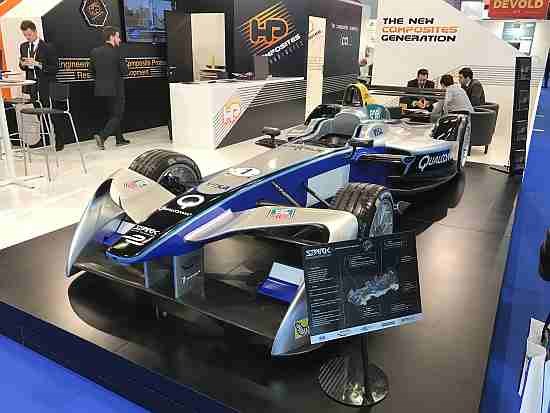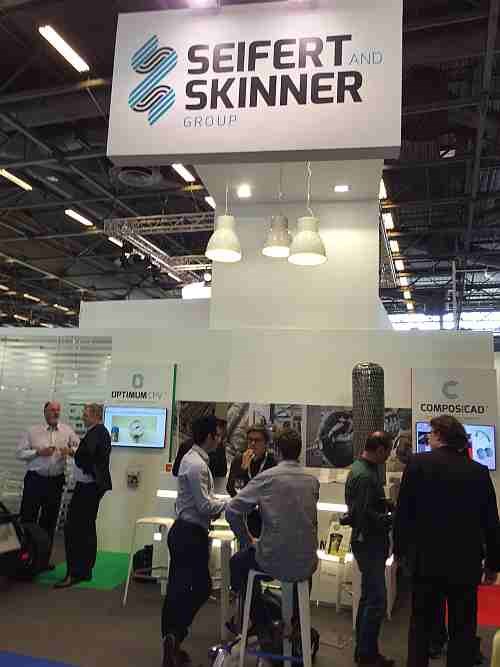Wait, wait, there’s more: JEC 2017
There’s never enough time to see everything at the JEC World event, and this year the problem was even worse. Here’s more information on new products and companies, from Paris…

A Formula E electric race car at HP Composites' stand.
There’s never enough time to see everything at the JEC World event, and this year the problem was even worse. In my initial JEC report (here’s the link: http://www.compositesworld.com/blog/post/another-opportunity-to-meet-and-learn-in-paris ), I ran out of time and couldn’t describe everyone I did get a chance to see and speak to. Here’s more information on new products and companies, from Paris…
HP Composites (Campolungo, Italy), part of the Everspeed Group (Paris, France), displayed a carbon-composite-intensive Formula E electric-powered race car from Spark Racing Technology at its stand. Founded in 2010, HP Composites has grown from a supplier of carbon parts for Formula1 and other racing organizations to a well-rounded manufacturer involved in production automotive, aerospace, marine, industrial and luxury goods. Its technologies range from autoclave to compression molding to resin transfer molding, and competencies span the entire gamut from engineering and prototyping through tooling to full industrialization. The group recently opened a US office (Denver, NC, US).
Fraunhofer Institute for Chemical Technology (Pfinztal, Germany) discussed Jute Bio-Comp, part of an international project for development of jute-fiber-reinforced bio-composites for industrial-scale application, supported by the German Federal Ministry of Education and Research. Fraunhofer ICT is working with the Karlsruhe Institute of Technology (KIT) as well as the Indian Ahmedabad Textile Industry’s Research Assn. (ATIRA), along with KraussMaffei and Dieffenbacher. Thai chemical company Aditya Birla Chemicals is the resin partner. The project aims to develop jute-fiber-reinforced composites that can be used in demanding, high-value technical applications for the international market.
In another natural fiber development, FiMaLin (Pont L’Eveque, France) — an industry group established to advance technical flax fibers — announced a new quality system for certifying natural fibers. The QUALIFLAX system, developed in cooperation with AFNOR Certification, provides “evidence of consistent technical performance, reliable supply and controlled pricing,” says the group. Natural fiber companies can now ask for a QUALIFLAX certification for their commercial range of products; AFNOR will conduct the audit at the company’s facility. QUALIFLAX is open to all natural fiber producers and downstream users.
Biteam AB (Stockholm, Sweden), which develops and manufactures an array of specialized carbon fiber 3D preforms, showed its unique solutions for advancing composite fabrication. Combination Architecture Beams are woven preforms with ±0° fiber orientations in the web(s), and 0/90° fiber orientations in the flanges. Web-flange junctions have mutual through-thickness interconnections to resist delamination, and beams display very high energy absorption capacity and damage resistance. Developed in response to specific performance demands from automotive and construction industries, these new 3D preforms offer stronger web-flange junctions than competing designs.

Seifert and Skinner Group (Draper, UT, US), experts in composite pressure vessel (CPV) engineering and design, had a joint booth combining their multiple businesses: Optimum CPV, focused on CPV development, testing and certification; ComposicaD, developer of software packages for filament winding and tape layup, for pipe, tanks and vessels, elbows and ducts, spars and non-circular sections, and flat panels; and Composiverse, which organizes composite industry events including CPVS 2017, to be held this year in Porto, Portugal. Traffic at the booth was increased by the presence of a composite pressure vessel filled with fresh Jessenhofke beer.
Wells Advanced Materials Co. Ltd. (WAM, Shanghai, China), exhibited its epoxy resin products, including HP-RTM Fast Curing products with cure times from 2 to 4 minutes, and Tg of at least 100°C or better, for industrial production. WAM has tested the fast-cure resins with a KraussMaffei HP-RTM machine and mixing head, that ensures complete mixing of resin and hardener. The company offers a range of epoxy products, also targeted to wind energy, filament winding, pultrusion and prepreg production, and flame-retardant versions are available as well.
Haydale Ltd. (Ammanford, Carmarthenshire, UK), which specializes in the design, testing, certification and commercialization of advanced composites, showed its bespoke nanomaterial-enhanced polymers, resins and composites, on an industrial scale. The group offers thermoset resins and thermoplastics, both containing its functionalized graphene material, as well as other nanomaterials. The company has a patented proprietary and scalable plasma process, called HDPlas, to engineer the surface chemistry of a customer’s materials, by adding desired chemical groups, providing greater dispersion, de-agglomerating, and more, for a customized solution. For example, HDPlas can functionalize graphene nanoplatelets (GNPs) for up to a 100% increase in structural strength and stiffness in carbon/epoxy composites. Haydale Technologies Inc. (HTI), the US division of Haydale Ltd., was recently chosen as a FiReStarter company by Strategic News Service.
Vestaro GmbH (Munich, Germany) showed its expertise in customizing epoxy and polyurethane-based formulations for high-speed liquid infusion systems in serial production. More than just a material supplier, the group works with a customer from the beginning, consulting on design and production, pre-development, and follows the process with any needed changes. Resin characteristics such as reactivity and other processing properties are selected and adapted to specific requirements for RTM, HP-RTM, wet compression molding, filament winding or pultrusion. In-mold coatings compatible with the resins are another product, also geared to short cycle times, and the group also offers formulations for epoxy-based sheet molding compounds (SMC) and polyurethane-based prepreg. Target applications are primarily automotive, but also include pressure vessels. Partners in the company include Forward Engineering (Munich, Germany) and Evonik (Essen, Germany and Herne, Germany).
Acciona Construcción SA (Alcobendas, Spain) was recognized, at the JEC’s “Building Planet” display as the winner of a JEC Innovation award for Construction. Along with its co-winners Owens Corning (Toledo, OH, US), Scott Bader (Wollaston, UK), CELO-APOLO Construction Systems, LUM-Industry, BYK-Chemie GmbH (Wesel, Germany) and Nanjing Loyalty Composite Equipment Manufacture Co. Ltd. (Nanjing, China), Acciona developed a design for thin, flexible fiberglass panels to line the interior of a leaking railway tunnel. The composite design could be deployed over the existing tunnel lining material without changing the tunnel diameter, and the corrosion-resistant panels’ interlocking features kept the water out, while still meeting all flame-retardant and fire/smoke/toxicity (FST) requirements. To make the 15,000 panels needed, at an acceptable cost, panels were pultruded.
Related Content
Materials & Processes: Resin matrices for composites
The matrix binds the fiber reinforcement, gives the composite component its shape and determines its surface quality. A composite matrix may be a polymer, ceramic, metal or carbon. Here’s a guide to selection.
Read MoreNovel dry tape for liquid molded composites
MTorres seeks to enable next-gen aircraft and open new markets for composites with low-cost, high-permeability tapes and versatile, high-speed production lines.
Read MorePEEK vs. PEKK vs. PAEK and continuous compression molding
Suppliers of thermoplastics and carbon fiber chime in regarding PEEK vs. PEKK, and now PAEK, as well as in-situ consolidation — the supply chain for thermoplastic tape composites continues to evolve.
Read MoreMaterials & Processes: Tooling for composites
Composite parts are formed in molds, also known as tools. Tools can be made from virtually any material. The material type, shape and complexity depend upon the part and length of production run. Here's a short summary of the issues involved in electing and making tools.
Read MoreRead Next
From the CW Archives: The tale of the thermoplastic cryotank
In 2006, guest columnist Bob Hartunian related the story of his efforts two decades prior, while at McDonnell Douglas, to develop a thermoplastic composite crytank for hydrogen storage. He learned a lot of lessons.
Read MoreComposites end markets: Energy (2024)
Composites are used widely in oil/gas, wind and other renewable energy applications. Despite market challenges, growth potential and innovation for composites continue.
Read MoreCW’s 2024 Top Shops survey offers new approach to benchmarking
Respondents that complete the survey by April 30, 2024, have the chance to be recognized as an honoree.
Read More









.jpg;maxWidth=300;quality=90)
















